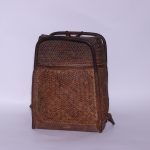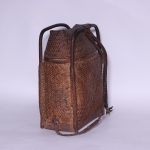Object Name: Pasiking/Hape-eng
Provenance: Mayoyao, Ifugao
Rattan
L. 25 cm, W. 34cm, H. 42 cm
Pasiking (also pahiking) refers to the woven backpack. They are held “generally in place by sturdy woven straps of rattan, which pass over the shoulders and underneath the arms and in their popularized headhunting past, referred to as a ‘head basket’.” (Silvestre, 2000, p. 108)
This type of pasiking is called hape’eng. “Hape’eng is the name the Ifugao use for their everyday backpacks, which are made in a variety of regional styles. This type of hape’eng, which is identified by its heavy rattan hoops, comes from the Ifugao town of Mayaoyao. The hoops provide a rigid structure that enables the backpack to be used as a stool by a weary traveler” (Hamilton, 1998, p. 99).
References:
Silvestre, R.E.J. (2000). The ethnoarchaeology of Kalinga basketry: When men weave baskets and women make pots (Doctoral dissertation, University of Arizona). University of Arizona Campus Repository.
Hamilton, R. W. (1998). Catalogue of the Exhibition. In L. Kostman & M. Ghaffari (Eds.).’ Basketry of the Luzon Cordillera, Philippines. Los Angeles, California: UCLA Fowler Museum of Cultural History.








